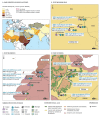Risk factors for MERS coronavirus infection in dromedary camels in Burkina Faso, Ethiopia, and Morocco, 2015
- PMID: 28382915
- PMCID: PMC5388105
- DOI: 10.2807/1560-7917.ES.2017.22.13.30498
Risk factors for MERS coronavirus infection in dromedary camels in Burkina Faso, Ethiopia, and Morocco, 2015
Abstract
Understanding Middle East respiratory syndrome coronavirus (MERS-CoV) transmission in dromedary camels is important, as they consitute a source of zoonotic infection to humans. To identify risk factors for MERS-CoV infection in camels bred in diverse conditions in Burkina Faso, Ethiopia and Morocco, blood samples and nasal swabs were sampled in February-March 2015. A relatively high MERS-CoV RNA rate was detected in Ethiopia (up to 15.7%; 95% confidence interval (CI): 8.2-28.0), followed by Burkina Faso (up to 12.2%; 95% CI: 7-20.4) and Morocco (up to 7.6%; 95% CI: 1.9-26.1). The RNA detection rate was higher in camels bred for milk or meat than in camels for transport (p = 0.01) as well as in younger camels (p = 0.06). High seropositivity rates (up to 100%; 95% CI: 100-100 and 99.4%; 95% CI: 95.4-99.9) were found in Morocco and Ethiopia, followed by Burkina Faso (up to 84.6%; 95% CI: 77.2-89.9). Seropositivity rates were higher in large/medium herds (≥51 camels) than small herds (p = 0.061), in camels raised for meat or milk than for transport (p = 0.01), and in nomadic or sedentary herds than in herds with a mix of these lifestyles (p < 0.005).
Keywords: Density; West - East gradient; herd size; milking activities; nomadic; sedentary.
This article is copyright of The Authors, 2017.
Conflict of interest statement
Figures



References
-
- WHO World Health Organization (WHO). Middle East respiratory syndrome coronavirus (MERS-CoV). Geneva: WHO; 2016. Available from:http://www.who.int/emergencies/mers-cov/en
-
- Seven days: 1–7 May 2015.Outbreak ending. Nature. 2015;523(7562):506-7. 10.1038/523506a - DOI
MeSH terms
Substances
Grants and funding
LinkOut - more resources
Full Text Sources
Other Literature Sources
Medical

